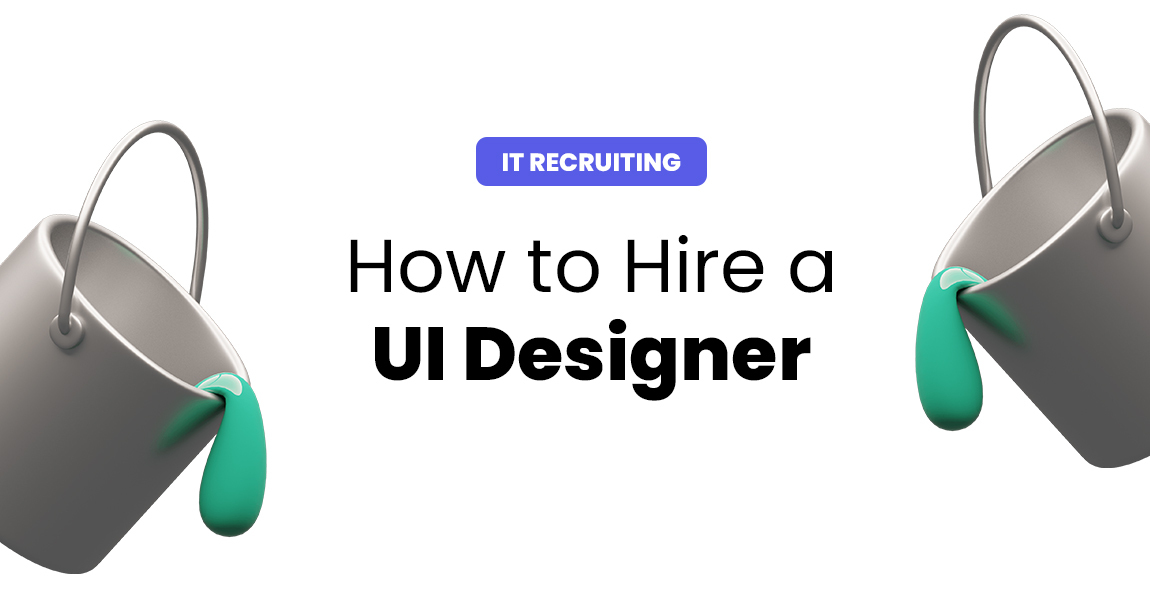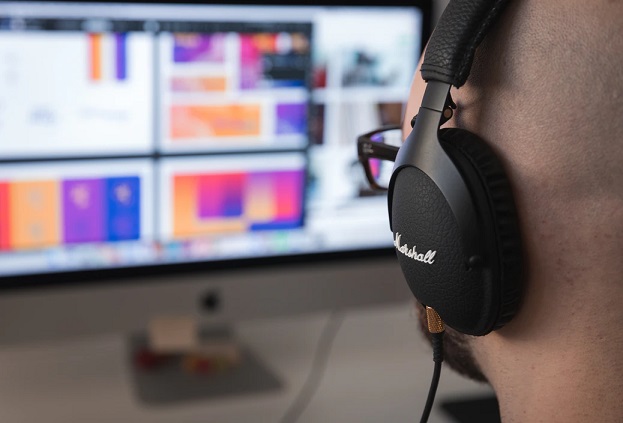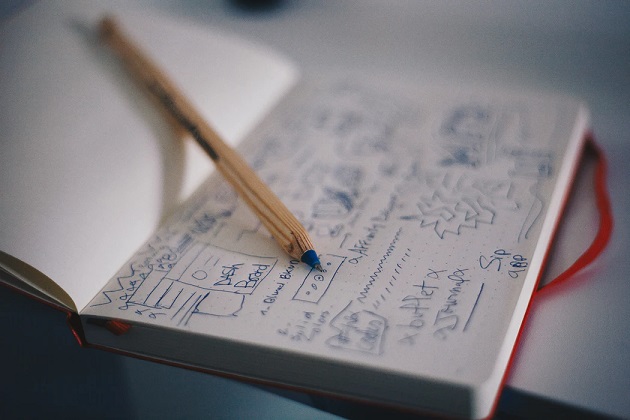IT Recruiting
How to Hire a UI Designer

Every hiring process commences with identifying a hiring need. Once the organization chooses to build up their product by considering the users’ preferences, necessities, and requirements, they should most likely reinforce their team with a UI Designer. Hiring a UI Designer should begin with creating an adequate recruitment strategy, and by writing an accurate Job Description. Once the hiring team gets the JD done, a whole lot of sourcing, screening, and interviewing are coming your way. But, first thing’s first – before you start looking for a UI Designer that will help your company create a beautifully arranged and functional product, you should make sure to understand their role fully.
What is UI design?
UI is short for User Interface, and one of its principal goals is to convey the brand’s values by paying attention to its visual representation and developing firm bonds with the users. UI betters the users’ understanding of the product, enhances their interaction with it, and enables them to have a pleasant experience. It simplifies and beautifies the route towards achieving users’ aims.
UI design represents the process of building interfaces in software or computerized devices, while Designers simultaneously focus on looks, features, and style.
What does a UI Designer do?
UI Designers attempt to create interfaces users find appealing and suitable. These specialists mainly concentrate on the surface. They carefully consider the appearance and layout. It is their responsibility to define how every element of the product should look.
Some of the features they are in charge of include buttons, text, and images, and other common elements. UI Designers think through their colors, shape, size, and placement, while following the guidelines, proven practices, brand’s and market’s requirements, and research results. In simple terms, – UI Designers build and ameliorate the entire visual experience.
While discussing UI Designers’ objectives, we can differentiate the visual part of their jobs from the “human” component they strive to incorporate into the product. Not only do their efforts enable users to navigate through the product quickly and trouble-free, but they also tend to form relationships between them and the product. UI Designers contribute to the users’ loyalty and awaken their willingness to come back.
UI and UX Designers collaborate closely. UI Designers ensure that each page and each step the user experiences when interacting with the complete product corresponds to the concept previously created by UX Designers.

Differences between UI and UX Designers
These two roles are often paired as UX/UI design because these terms form a supreme combination. UX/UI Designers build extraordinary websites, applications, games, and other digital products. Still, there is an essential difference between UX and UI design.
The most straightforward way of separating UI from UX design is by saying that UX makes sure an interface is serviceable and practical, while UI makes it exquisitely aesthetic. UX design is oriented towards the analysis and gaining insights into things like the potential problems customers might encounter, market gaps, and it researches competition.
What makes a UI design good?
Users are quick to judge a product. The parameters they usually have in mind include visual experience and the amount of effort they need to invest in utilizing the product. UI Designers aim to provide users with a pleasurable experience.
However, even though each UI Designer will take a moment to contemplate the aesthetics of a product and its features, they must be aware of the fact that users tend to praise those products that celebrate simplicity and save their time.
Look for a UI Designer who is familiar with these simple rules & has the qualities we listed below.
Honesty and clarity:
UI Designers should always remain honest, direct, and consistent. UI represents ideas or products that lead their users to success.
Social proof:
Each positive feedback should be used to help potential users obtain a better image of the product. UI can be strengthened by pointing towards the traces of customer satisfaction through references or testimonials.
Confidence:
… With a dash of authoritative. Avoiding anything that feels indecisive is an excellent way to become trustworthy.
Simplicity & ease of use:
Creating a predictable scenario for users increases their willingness to use the product. Direct their focus to those features that will help them reach their goals in no time.
Style:
UI Designers must pay attention to colors, styles of clickable actions, elements, items, and plain text.
Merging:
Great UI can be achieved by merely uniting similar functionalities. Repeatedly creating features with the same purposes would affect the users negatively.

UI Designer Job Description
Every Job Description should start with an introduction. Writing a concise and engaging paragraph about a company will help job seekers and passive candidates learn more about their potential employer. They should be able to read sufficient information about the company’s culture, values, and benefits. Working hours and remote working possibilities should be fused into the JD as well. Everything that makes the company stand out should be in plain sight.
The first sentence that follows the introduction should represent the candidate persona in short. Candidates should understand precisely what the company is looking for once they read it. It should name a few qualities the new hire should possess, their experience, seniority, their background, the structure of the teams they’ve previously worked within, and methodologies (Scrum, Kanban, Waterfall) they’re comfortable with.
The next two paragraphs should include Responsibilities and Requirements.
UI Designer Job Description Template
Position Overview
[Company Name] is seeking a talented UI Designer to create intuitive and visually compelling digital experiences. You’ll collaborate closely with cross-functional teams to transform user needs into polished, functional interfaces that align with business objectives.
Key Responsibilities
Design & Development
- Design user interfaces for [web/mobile/desktop] applications using industry best practices
- Create comprehensive design systems, wireframes, prototypes, and interactive mockups
- Develop and maintain style guides to ensure visual consistency across [products/platform]
- Transform complex user flows into clean, intuitive interface designs
Collaboration & Communication
- Partner with UX designers, developers, product managers, and stakeholders throughout the design process
- Present design concepts and rationale to team members and leadership
- Iterate on designs based on user feedback, usability testing, and business requirements
- Participate in design reviews and provide constructive feedback to peers
Professional Growth
- Stay current with emerging design trends, tools, and technologies
- Apply design principles including typography, color theory, layout, and visual hierarchy
- Contribute to design process improvements and team knowledge sharing
Required Qualifications
Experience & Portfolio
- [X]+ years of professional UI design experience
- Strong portfolio demonstrating end-to-end design process and problem-solving abilities
- Proven track record of shipping successful digital products
Technical Skills
- Proficiency in design tools such as [Figma/Sketch/Adobe Creative Suite/other preferred tools]
- Experience creating wireframes, prototypes, and interactive mockups
- Basic understanding of HTML, CSS, and JavaScript principles
- Familiarity with design systems and component libraries
Core Competencies
- Strong visual design skills with attention to detail and pixel-perfect execution
- Excellent problem-solving abilities and analytical thinking
- Outstanding communication and presentation skills
- Experience working in [Agile/Scrum/other] development environments
- Ability to balance user needs, business goals, and technical constraints
Preferred Qualifications
- Experience with motion design and micro-interactions
- Knowledge of accessibility standards and inclusive design principles
- Background in user research or usability testing
- Previous experience in [relevant industry/domain]
- [Add any company-specific preferred qualifications]
What We Offer
- [Salary range]
- [Benefits package details]
- [Professional development opportunities]
- [Company culture highlights]
- [Remote/hybrid/on-site work arrangement]
Instructions for Use:
- Replace bracketed placeholders with company-specific information
- Adjust years of experience requirement based on seniority level
- Customize technical skills based on your technology stack
- Add industry-specific requirements in preferred qualifications
- Include your company’s unique benefits and culture details
UI Designer Interview Questions
Interview Overview
These questions should be tailored to align with your company’s specific needs, culture, and project requirements. Adjust the complexity and focus areas based on the candidate’s experience level and your team’s current challenges. Each interview should be personalized while maintaining a structured approach to evaluate essential skills and cultural fit.
Core Competency Questions
Design Process & Methodology
- Walk me through your typical design process from initial brief to final handoff.
- What information do you need from stakeholders before beginning a new design project?
- How do you approach timeline estimation for design work? What factors influence your estimates?
- Describe how you handle feedback and iteration cycles in your design process.
Technical Skills & Tools
- What design tools are you most proficient with, and how do you decide which tool to use for different projects?
- How do you ensure design consistency across multiple screens or platforms?
- Explain your approach to creating and maintaining design systems.
- What’s your experience with [specific tools relevant to your company’s workflow]?
Design Thinking & Problem-Solving
- Describe a challenging design problem you’ve solved recently. What was your approach?
- How do you balance user needs with business requirements and technical constraints?
- Tell me about a time when you had to defend a design decision. How did you approach it?
- How do you stay current with design trends while maintaining timeless usability principles?
Portfolio & Experience Review
Project Deep-Dive
- [Select a specific project from their portfolio] Can you walk me through the design decisions you made for this project?
- What would you do differently if you were to redesign this project today?
- How did you measure the success of this design?
- What challenges did you face during this project, and how did you overcome them?
Industry Knowledge
- What do you consider to be examples of excellent UI design currently? What makes them effective?
- Can you identify a popular app or website with poor UI design? How would you improve it?
- How do you approach designing for accessibility and inclusive design?
Team Collaboration & Culture Fit
Working Style
- Describe your experience collaborating with developers. How do you ensure smooth handoffs?
- How do you handle conflicting feedback from multiple stakeholders?
- Tell me about a time when you had to work under tight deadlines. How did you prioritize?
- What does effective design critique look like to you?
Company-Specific Questions
- [Customize based on your company] How would you approach designing for [our specific industry/user base]?
- What interests you about working at [Company Name]?
- How do you see yourself contributing to our design team’s goals?
Practical Assessment Options
Design Exercise (Choose one based on your needs)
- Whiteboard a solution for [relevant design challenge]
- Review and critique [existing company interface or competitor]
- Walk through how you would approach [specific project type relevant to role]
Evaluation Framework
Technical Skills
- Proficiency with relevant design tools
- Understanding of design principles
- Portfolio quality and diversity
- Problem-solving approach
Collaboration & Communication
- Ability to articulate design decisions
- Receptiveness to feedback
- Team collaboration experience
- Stakeholder management skills
Cultural Fit
- Alignment with company values
- Growth mindset and adaptability
- Passion for design and continuous learning
- Communication style and professionalism
Customization Tips:
- Replace bracketed placeholders with company-specific details
- Adjust question complexity based on seniority level (junior/mid/senior)
- Include questions about your specific design challenges or tools
- Add industry-specific scenarios relevant to your business
- Consider cultural values important to your organization
Hiring a UI Designer
If you’re hiring a UI Designer, you might consider collaborating with a recruitment agency. Recruiters can take charge of sourcing talent, going through their CV’s and portfolios, conducting phone screening, and provide you with valuable insight into candidates’ knowledge. You’d be receiving resumes of only those UI experts that match your requirements, culture, values, and mission.
Are you ready to start hiring? Tell us about it.